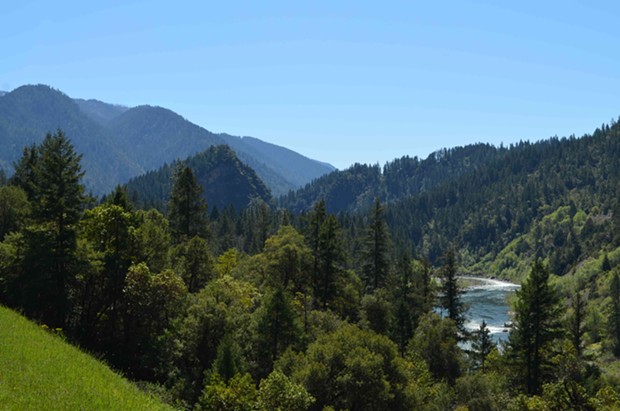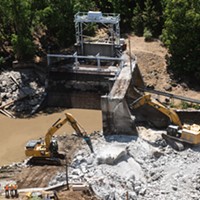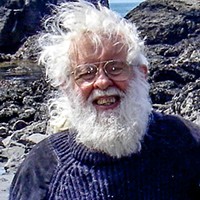Tuesday, August 25, 2015
Connecting Freshmen to the Klamath
Posted By Grant Scott-Goforth @GScottGoforth on Tue, Aug 25, 2015 at 1:48 PM
A small group of Humboldt State University’s largest-ever freshman class got a VIP-worthy introduction to the county last week through one of the North Coast’s most important resources: the Klamath River.
More than 60 students cut their summer breaks short to head up to Arcata early this year as part of an experimental new program designed to enhance learning and retention rates in HSU’s science programs.
As part of a national effort to encourage people to study the STEM fields (science, technology, engineering and math) HSU professors Amy Sprowles and Matt Johnson developed the “Klamath Connection” as a way to encourage students to connect with the area and learn skills that will help their academic and professional careers.
“It’s a profoundly different way to approach freshmen,” Johnson said, and a method that he and Sprowles are calling “place-based learning.”
On an overnight camping trip in Orleans, about 20 of the students involved in the summer immersion program spoke with scientists from the Karuk Tribe, who emphasized how important it was to have accurate data regarding water quality. Other students visited the Arcata Marsh, and the entire summer immersion group visited the mouth of the Klamath River, where they talked with members of the Yurok Tribe about the importance of the river as a cultural, economic and environmental resource. And by connecting to the river, Sprowles said, the students connect to the people that rely on the river.
"The students were really affected by many of the stories they heard, and impressed at how dedicated the Karuk tribe is to protecting the Klamath River ecosystem" she wrote in an email.
Johnson said many of the students in the immersion program came from Los Angeles and the Bay Area (reflecting the general freshman population), which are vastly different from Humboldt ethnically, geographically and culturally. So getting to know the Klamath acts as an introduction to the area. But the summer immersion program wasn’t just social, it had a rigorous academic component, which Johnson said the students were eager to take on.
But the Klamath will weave its way through their school career, and beyond, if the program is successful. “We’re doing this with the Klamath basin because it’s a great lens to examine the intersection of a lot of different disciplines,” Johnson said.
Some of the general education science courses provided the next two semesters will feature lessons on the Klamath, and students involved in the program will take a special seminar course. It’s an opportunity for faculty members to bring issues that they care about into the classroom, and help students with broad science interests focus on a specific area of study. The final feature of the program is a peer mentor group, which helps the freshmen socially as well as academically. Johnson said the idea is to increase retention — to keep science majors in the science fields — and graduation rates.
Johnson and Sprowles believe that their students can take lessons from the Klamath far beyond Humboldt County, wherever their careers may take them. Algae blooms, for example, are a worldwide concern, Sprowles said.
“Even though some aspects are Klamath specific,” Sprowles wrote. “Many of the issues are seen around the world. Our hope is that this program will allow Klamath Connection students to more clearly see ways that their discipline relates to issues going on in their own communities.”
Working with native cultures is important in any scientific endeavor, Johnson said. He hopes the program will help students set a “tone of cultural sensitivity, inclusiveness — to connect with landscape and people as well. … We’re really purposeful about that connection.”
HSU was one of eight California State Universities awarded grants from the Leona M. and Harry B. Helmsley Charitable Trust, and received $375,000 to develop and administer the program for two years.
Students from four departments — biology, wildlife, environmental science and zoology — will participate in the program this year, and Johnson hopes that success will inspire the university to continue to fund the Klamath Connection and develop similar programs for other disciplines and for other resources: Humboldt Bay, the redwood forests and more.
So far, Sprowles said, it seems to be working. “I’ve taught introductory science labs to freshman and seniors for the last nine years. The Klamath Connection students showed an extremely high level of engagement and motivation to successfully execute the exercise. … It is one the most exciting projects I’ve ever participated in as a teacher, a scientist and a person.”
More than 60 students cut their summer breaks short to head up to Arcata early this year as part of an experimental new program designed to enhance learning and retention rates in HSU’s science programs.
As part of a national effort to encourage people to study the STEM fields (science, technology, engineering and math) HSU professors Amy Sprowles and Matt Johnson developed the “Klamath Connection” as a way to encourage students to connect with the area and learn skills that will help their academic and professional careers.
“It’s a profoundly different way to approach freshmen,” Johnson said, and a method that he and Sprowles are calling “place-based learning.”
On an overnight camping trip in Orleans, about 20 of the students involved in the summer immersion program spoke with scientists from the Karuk Tribe, who emphasized how important it was to have accurate data regarding water quality. Other students visited the Arcata Marsh, and the entire summer immersion group visited the mouth of the Klamath River, where they talked with members of the Yurok Tribe about the importance of the river as a cultural, economic and environmental resource. And by connecting to the river, Sprowles said, the students connect to the people that rely on the river.
"The students were really affected by many of the stories they heard, and impressed at how dedicated the Karuk tribe is to protecting the Klamath River ecosystem" she wrote in an email.
Johnson said many of the students in the immersion program came from Los Angeles and the Bay Area (reflecting the general freshman population), which are vastly different from Humboldt ethnically, geographically and culturally. So getting to know the Klamath acts as an introduction to the area. But the summer immersion program wasn’t just social, it had a rigorous academic component, which Johnson said the students were eager to take on.
But the Klamath will weave its way through their school career, and beyond, if the program is successful. “We’re doing this with the Klamath basin because it’s a great lens to examine the intersection of a lot of different disciplines,” Johnson said.
Some of the general education science courses provided the next two semesters will feature lessons on the Klamath, and students involved in the program will take a special seminar course. It’s an opportunity for faculty members to bring issues that they care about into the classroom, and help students with broad science interests focus on a specific area of study. The final feature of the program is a peer mentor group, which helps the freshmen socially as well as academically. Johnson said the idea is to increase retention — to keep science majors in the science fields — and graduation rates.
Johnson and Sprowles believe that their students can take lessons from the Klamath far beyond Humboldt County, wherever their careers may take them. Algae blooms, for example, are a worldwide concern, Sprowles said.
“Even though some aspects are Klamath specific,” Sprowles wrote. “Many of the issues are seen around the world. Our hope is that this program will allow Klamath Connection students to more clearly see ways that their discipline relates to issues going on in their own communities.”
Working with native cultures is important in any scientific endeavor, Johnson said. He hopes the program will help students set a “tone of cultural sensitivity, inclusiveness — to connect with landscape and people as well. … We’re really purposeful about that connection.”
HSU was one of eight California State Universities awarded grants from the Leona M. and Harry B. Helmsley Charitable Trust, and received $375,000 to develop and administer the program for two years.
Students from four departments — biology, wildlife, environmental science and zoology — will participate in the program this year, and Johnson hopes that success will inspire the university to continue to fund the Klamath Connection and develop similar programs for other disciplines and for other resources: Humboldt Bay, the redwood forests and more.
So far, Sprowles said, it seems to be working. “I’ve taught introductory science labs to freshman and seniors for the last nine years. The Klamath Connection students showed an extremely high level of engagement and motivation to successfully execute the exercise. … It is one the most exciting projects I’ve ever participated in as a teacher, a scientist and a person.”
Speaking of...
Readers also liked…
more from the author
-
Flamin' Hot's Stale Corporate Propaganda
- Jun 15, 2023
-
Hell is Visiting Other People
- Sep 22, 2022
-
The Bear Roars
- Aug 18, 2022
- More »




































